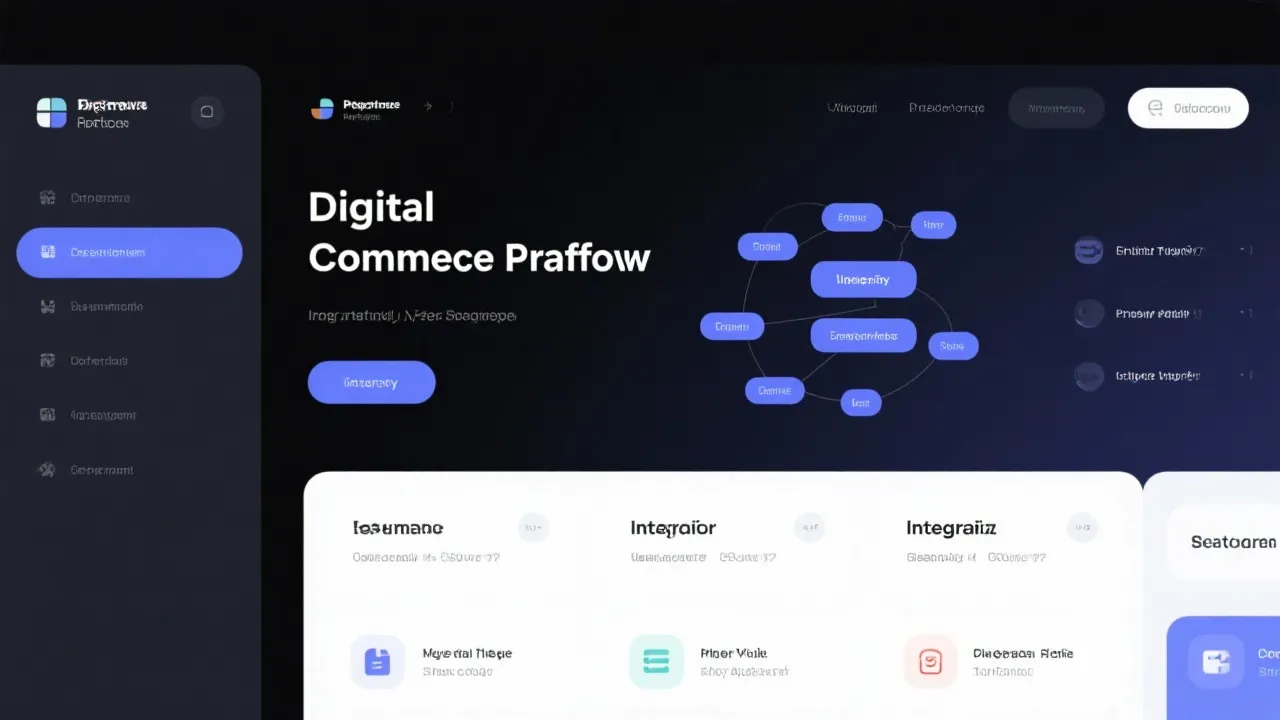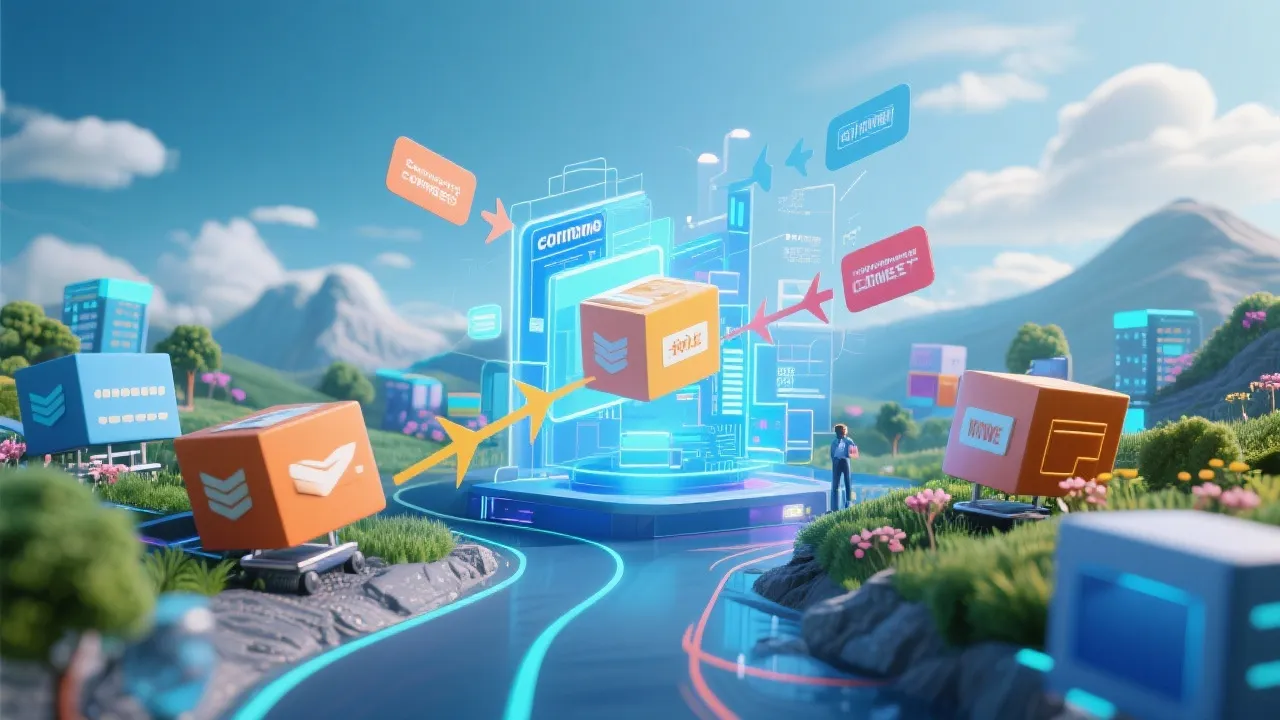E-commerce Giants: Vtex and Salesforce
This article explores the competitive dynamics between Vtex and Salesforce, two leading e-commerce platforms that cater to diverse business needs. Vtex offers a customizable and scalable solution for rapidly growing businesses, while Salesforce's strength lies in its integrated CRM capabilities. Both platforms provide robust tools and services essential for digital transformation.

A Deeper Look into E-commerce Platforms: Vtex and Salesforce
In the evolving digital landscape, e-commerce platforms are the backbone of online retail businesses. Among the many options available, Vtex and Salesforce emerge as leaders due to their unique capabilities and comprehensive offerings. This article provides an in-depth analysis of these platforms, highlighting their strengths and differentiating factors.
Understanding Vtex's E-commerce Solution
Vtex presents itself as a flexible, cloud-based e-commerce platform suitable for enterprises aiming for growth and scalability. It integrates seamlessly with other systems, allowing businesses to tailor their online stores to specific needs. Known for its microservices architecture, Vtex offers the flexibility to add or modify features without disrupting the entire system.
One key advantage is its collaborative commerce solutions, which enable businesses to create multi-vendor marketplaces effortlessly. This feature is particularly appealing for companies looking to expand their product offerings without significant investment in new inventory. By using Vtex, brands can leverage partner networks to enrich their catalogs, tapping into an extended reach without the logistical burden of inventory management.
Furthermore, Vtex has been increasing its focus on enhancing user experience through tools such as personalized product recommendations, AI-driven chatbots, and responsive design templates. This allows retailers to provide their customers with a seamless shopping journey across all devices.
Another notable feature of Vtex is its emphasis on speed and performance. The platform's architecture allows for rapid loading times and efficient processing, which are crucial for retaining customers in an environment where users demand quick and reliable shopping experiences. This performance enhancement not only improves customer satisfaction but can also positively impact search engine rankings.
Exploring Salesforce's E-commerce Strengths
Salesforce, renowned for its CRM capabilities, extends its expertise into e-commerce through Salesforce Commerce Cloud. This platform emphasizes customer engagement and offers comprehensive solutions that integrate customer data across various channels. Such integration facilitates personalized marketing strategies, enhancing customer satisfaction and loyalty.
The strength of Salesforce lies in its robust data analytics and artificial intelligence-driven insights, allowing businesses to tailor the customer experience effectively and streamline operations to boost revenue. Salesforce's AI, known as Einstein, empowers businesses to mine customer data for valuable insights, predicting behaviors and preferences that can shape future marketing and sales strategies.
Additionally, Salesforce Commerce Cloud offers out-of-the-box features like A/B testing, which is crucial for understanding what resonates with consumers. This ensures that businesses can adapt their approaches based on actual user interactions and preferences.
Salesforce’s extensive ecosystem of apps further enhances its e-commerce prowess. Companies can integrate various third-party applications through the Salesforce AppExchange, broadening capabilities without compromising existing operations. From inventory management to customer service enhancements, the applications available create a robust infrastructure for e-commerce success.
Vtex vs. Salesforce: A Comparative Analysis
While both platforms cater to businesses seeking digital transformation, there are notable differences:
| Aspect | Vtex | Salesforce |
|---|---|---|
| Architecture | Microservices, Flexible | Integrated CRM, AI-driven |
| Target Audience | Growing Enterprises, Multi-vendor Marketplaces | Customer-Centric, Data-Driven Strategies |
| Core Features | Customizable, Scalable, Collaborative Commerce | CRM Integration, Personalization, AI Insights |
In terms of scalability, Vtex may appeal more to businesses looking for growth as it allows them to build customized solutions. On the other hand, businesses that prioritize customer relationship management and data analytics might lean toward Salesforce to take full advantage of the embedded CRM functionalities.
Moreover, while both platforms offer tools for marketing automation, Salesforce shines in its comprehensive customer engagement suite, which can prove to be more beneficial for brands focusing heavily on nurturing client relationships over time.
The Impact of Location in E-commerce Implementation
While both Vtex and Salesforce accommodate global operations, their effectiveness can be enhanced by understanding localized needs. In areas with specific regulatory requirements or consumer behavior patterns, tailoring the platform is crucial for compliance and user engagement. Localization can include everything from language translation capabilities to conformity with local tax laws and payment preferences.
This localization extends to logistics as well; both platforms offer solutions to integrate with local shipping and payment systems, ensuring a seamless customer experience from purchase to delivery. Vtex, for instance, has established partnerships with various logistics providers across different regions, making shipping solutions more streamlined and efficient. Salesforce also offers various integrations that allow businesses to connect with local payment gateways for smoother transactions.
Moreover, culturally aware marketing can significantly impact the success of e-commerce platforms in different regions. Understanding cultural nuances allows businesses to create campaigns that resonate more effectively with local populations, thereby enhancing engagement and conversion rates.
Future Trends in E-commerce
As the e-commerce landscape continues to evolve, there is a growing emphasis on sustainability and ethical consumerism. Platforms like Vtex and Salesforce are beginning to incorporate features that allow businesses to measure and reduce their carbon footprint. Sustainability initiatives, such as carbon offset programs and eco-friendly logistics, are becoming essential in attracting socially conscious consumers.
Moreover, AI and machine learning will continue to play significant roles in predictive analytics and customer support automation. These technologies will enable more personalized experiences, such as adaptive web interfaces that change in real-time based on user behavior and preferences.
Lastly, with the rise of mobile commerce and voice-assisted shopping, both Vtex and Salesforce are investing in technologies to enhance mobile user experiences and voice recognition capabilities. The shift towards mobile shopping necessitates a focus on responsive design and mobile-optimized payment solutions, ensuring that platforms cater to this growing consumer behavior.
As augmented reality (AR) and virtual reality (VR) gain traction, we can also expect to see innovative solutions that merge physical and digital shopping experiences, offering customers a more immersive way to engage with products online. Companies utilizing these technologies can potentially enhance customer satisfaction and decrease return rates due to better-informed buying decisions.
FAQs
Q1: How do Vtex and Salesforce integrate with existing business systems?
A1: Both platforms offer comprehensive APIs and integration tools that facilitate seamless connectivity with existing systems, whether it's ERP, CRM, or other third-party applications. This ability to integrate widely ensures businesses can maintain their established workflows while benefiting from new features offered by the platforms.
Q2: Can small businesses benefit from these platforms?
A2: Yes, while they are robust enough for large enterprises, both Vtex and Salesforce offer scalable solutions for small to mid-sized businesses seeking growth and customer engagement. These platforms allow smaller companies to access advanced e-commerce solutions that were traditionally available only to larger enterprises, leveling the playing field.
Q3: Are there specific industries that benefit from Vtex and Salesforce?
A3: Industries with significant online sales, such as retail and consumer goods, benefit significantly, but the platforms are versatile enough to cater to various sectors, including B2B services. Industries like fashion, electronics, and home goods have found great success using these platforms to enhance their online presence and streamline operations.
The Importance of Customer Experience in E-commerce
Customer experience is a central focus for both Vtex and Salesforce, each offering tools that empower businesses to enhance user engagement throughout the shopping journey. From initial interactions on the website to post-purchase follow-ups, the importance of a smooth and enjoyable customer experience cannot be overstated.
Vtex helps optimize customer interactions by providing features like personalized shopping experiences based on user behavior, ensuring that visitors are presented with products that match their interests and previous interactions. This can significantly reduce bounce rates and increase conversion rates, as customers are more likely to make a purchase if they feel understood and valued.
Salesforce takes this a step further with its powerful CRM capabilities. The seamless integration of data allows businesses to track customer behavior across all touchpoints, enabling tailored marketing campaigns that resonate deeply with their audience. For instance, using customer purchase history to provide targeted promotions can lead to higher sales and customer retention.
Moreover, both platforms support customer feedback mechanisms, which can provide businesses with insights crucial for continuous improvement. By actively soliciting and responding to customer opinions, companies can adapt to the evolving preferences and desires of their target marketplace, staying ahead of competitors.
Conclusion: Choosing the Right E-commerce Platform
Ultimately, the decision between Vtex and Salesforce will depend on a business's specific needs, goals, and existing technology infrastructure. Each platform offers unique strengths that cater to different facets of e-commerce, whether it's flexibility and scalability with Vtex or data-driven strategies and customer engagement with Salesforce.
Companies must consider their current and future growth trajectories, budget constraints, and the value they place on customer relationships when selecting the right e-commerce solution. A thorough assessment and understanding of operational requirements will ensure that the chosen platform can support long-term success in an increasingly complex digital economy.
Both Vtex and Salesforce are designed to meet the needs of modern e-commerce businesses, and choosing wisely will pave the way for enhanced efficiency, increased revenue, and a loyal customer base. The digital marketplace is competitive, and leveraging the right technology is essential for making a lasting impact. Whether businesses choose Vtex for its customization or Salesforce for its rich data insights, ensuring alignment with strategic objectives is the key to unlocking the full potential of e-commerce.
-

A Guide to Cost-Efficient Small Electric Cars for Seniors
-

Mastering Debt Consolidation: Boost Your Credit Score and Manage Interest Rates
-

Your Guide to Loans, Credit Checks, and Interest Rates
-

Affordable Independent Living: Finding the Right Senior Housing
-

Guide to Senior Living Apartments: Affordable and Comfortable Environments









